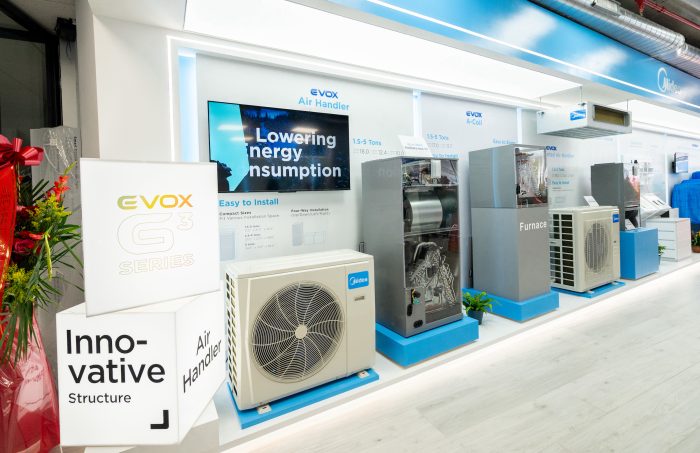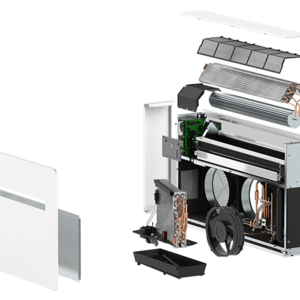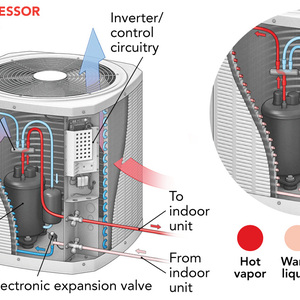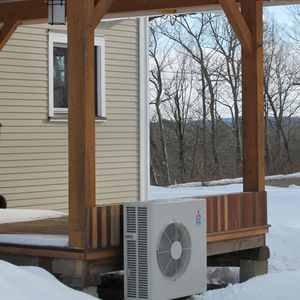
It’s official. Heat pumps have achieved mainstream status. Last February, global appliance company Midea opened its HVAC Showroom in the Fresh Meadows section of Queens, New York. Developed and operated in partnership with New York-based Ai-Midea Air Conditioning, the corporation’s dedicated HVAC company, this showroom is a first-of-its-kind for the U.S. While not a retail destination in the strictest sense, the location’s storefront configuration along a busy thoroughfare is no accident. Midea wants to reach consumers directly.
Upon entering the new showroom, visitors can engage with various models of cold climate, wall-mounted mini-splits, ducted systems, heat pump water heaters, window heat pumps, and related appliances suited to a wide range of single- and multi-zone residential dwellings and light commercial spaces. As exciting as this is for an industry that is currently projected to reach $157.8 billion in market share by 2029 (up from $90 billion in 2024), according to MarketsandMarkets, it still begs the question: does it make fiscal sense to market these kinds of products to a consumer base?
According to David Rames, a senior product manager at the Midea America Research Center, based in in Louisville, Kentucky, “We have done a lot of consumer research. And even though [consumers] are more educated than ever, HVAC is just not one of those things that is top of mind.” Rames draws a parallel between this showroom innovation and car dealerships. “When you want to buy a car, you want to open the doors and sit in the seat and kick the tires. This showroom gives consumers the opportunity to do that.”
Educating consumers to be better customers
As a kid growing up in the suburban outskirts of NYC, I would often attend the International Auto Show at the Javits Center with my dad, and on at least one occasion its boat show counterpart. These events thrive on spectacle, with a gaggle of turntables and ostentatious banners and glossy demonstrations to lure us in. Everything gleams pure metallic; the air is a palpable blend of turtle wax and stale cologne. Of course, those in attendance understand the format; a direct-to-consumer arrangement this is not. Spectacle, yes, but at its core, people are there to learn. In that respect, the auto show model is probably more analogous to Midea’s new showroom than Rames’s example of dealerships, which are the legal mechanism by which auto manufacturers reach consumers. (State franchise laws prohibit direct manufacturer-to-consumer sales of new automobiles.)
In that tradition, if not in practice, the average homeowner isn’t meant to walk into Midea’s showroom and purchase a new heat pump outright. Ai-Midea is the local wholesaler, which means that while consumers can come in and get educated on the latest models and associated energy savings, within reason, any transaction is ideally left to the professionals. “The customer can interact with us, but that doesn’t mean they are going to buy equipment from us and directly install it at home themselves,” says Dr. Wenqing Zhang, CEO of Ai-Midea Air Conditioning. “It’s going to go through the contractor for sure.” Zhang outlines an ideal scenario in which the consumer peruses the latest tech and brings that information back to their preferred contractor. “Once they know the machine’s functionality, they can work with their [HVAC contractor] to purchase the equipment” and right-size it for their home.

Strategically this makes sense. After all, even the most learned homeowner is unlikely to enter the showroom with detailed specs in hand, including livable square footage, building repair history, blower door test results, and other relevant factors that will determine why type (and size) of heat pump model will meet their needs. “We’ll leave it to the contractor to do the Manual J and the blower door to check all that,” Rames says.
Without relevant context, employees on the Midea showroom floor will stop short of guaranteeing savings (both energy and cost) for the consumer. That said, having this kind of upfront engagement with the products definitely constitutes a level of customer service that is currently lacking within the industry. “We just want people to know what technology is available to them,” Rames says. “And that way, the process becomes a little more comfortable than simply having a contractor with a piece of literature sitting at their kitchen table.”
Another layer to that hands-on education concerns what local rebates and federal tax credits are available to consumers, like the Energy Efficient Home Improvement Credit (aka 25C credit), extended through the IRA, and whether certain criteria is met for homeowners to qualify. Complementing that, the showroom will double as a place for contractors to receive training programs, according to Midea’s press release, and equip “industry professionals with the necessary expertise for installation and maintenance.”
A replicable model
While this consumer-centric approach is unique for the U.S. market, it is not without precedent. Other HVAC companies have well-established showrooms in U.S. cities far and wide, albeit with a wholesale business model. That list includes a Daikin showroom in nearby Long Island City, just west of Midea’s Fresh Meadows location. To Midea’s example, however, Zhang and Rames both cite a Daikin showroom they visited in Japan, appropriately located within a shopping mall, that is equal parts of exhibition space and retail store. That research excursion illustrated new possibilities for the U.S. heat pump marketplace.
“We’re not copying that model, but we can bring the concept to the U.S. because we think there’s a lot of value for [consumers] to be able to put their hands on these products and talk to real professionals and product leaders who understand them. And that gives people more confidence and better buying power,” Rames says. The importance of this cannot be overstated, especially when considering how arduous and cost-intensive a HVAC replacement can be for homeowners, even with tax rebates and credits factored in. “Other than replacing the roof on your house, [heating and cooling] is the second most expensive investment in your home,” Rames continues. “We want to make sure that if you’re going to spend that kind of money, that you’re knowledgeable and make educated decisions.”
The staying power of such an endeavor remains unproven. And unlike the spectacle of an auto show, where floor models may be a year or two away from mass production (if at all), a heat pump showroom must achieve something else entirely: evoke a futuristic, state-of-the-art excitement while also feeling timely and accessible. The future is now, and you can have it!
Thus far, there is cause for optimism. People are noticing. And if something as simple as a showroom with some practical tweaks can educate both average consumers and industry professionals on the critical importance of energy efficiency and electrifying our heating and cooling sources, then what’s to stop other industry players from replicating this?
“I had a someone yesterday fly in from Florida to visit the showroom,” Zhang says. “One day trip, fly in, fly out. It was good.”
_______________________________________________________________________
Justin R. Wolf is a Maine-based writer who covers green building trends and energy policy.
Weekly Newsletter
Get building science and energy efficiency advice, plus special offers, in your inbox.















10 Comments
Please lobby the US regulators to allow R290 refrigerant (propane) use in monobloc hydronic heat pumps (such as is becoming common in Europe this year)!
eg:
https://mbt.midea.com/hvac-goods/midea-products-category/heat-pumps/r290-m-thermal-arctic-ht-series
A capability of 75C/167F water temperature output makes retrofitting the vast majority of hydronic heating systems in the US possible without expensive radiation upgrades. In the current US subsidy environment this makes a huge difference, since there is cap to the tax credits for air source heat pump (ASHP) projects, whereas there is NO cap for ground source heat pump (GSHP) systems. With the lower upper bound on water temps using R454B, R32, or R410A refrigerants the installed system costs including radiation improvements can approach or exceed $100KUSD, the additional subsidy for GSHP can make it favorable relative to comparable performance hydronic output ASHP.
In places where R290 is allowed in ASHP monobloc systems (no refrigerant is inside the house), replacing a boiler (particularly condensing boilers) with a heat pump is much simpler. It's still more expensive than air-to-air (assuming preexisting ducts of adequate size) but a fraction of the cost of a GSHP system, and usually cheaper than ductless air to air. The recent EU regulatory increase in the allowable amount of flammable refrigerants has turned into a boom for R290 heat pumps- 2024 should be a banner year! All major vendors of heat pump equipment have scrambled into that market, fully on board with extensive product lines. On this side of the pond we're waiting and wondering (not really hoping yet.)
With monobloc systems it SHOULD be a no-brainer, since all of the flammable refrigerant is outdoors. The amount of propane in the average patio grill (ubiquitous in the US) is quite a bit more than would be in a 3-5 ton R290 monobloc heat pump. (Those outdoor cooking appliances are less well contained tend to be less well maintained than a heat pump would be too.)
The latest round of window-heat-pump systems from Gradient. and in NYC, Midea (under last year's competitive bidding) are tiny monobloc systems, but pretty still pretty expensive compared to mini-splits of comparable capacity. I don't believe those are using R290 either, but they arguably SHOULD be, from an efficiency and greenhouse gas impact point of view. Rumor has it the Midea window heat pump will become generally available later this year (pricing TBD.)
The EPA has proposed allowing up to 500 g of propane in residential systems. I don't know if that's enough for a monobloc system.
One of the benefits of R290 is that propane has no ozone depleting properties. Aside from being a benefit unto itself, it means that you don't have to be EPA-licensed to handle it.
I believe the 2 ton units have around 600g of R290. The next sizes up all have 1kg+ of R290. So 500g still doesn't get the job done.
Meanwhile 20 lb barbecue tanks are everywhere.
Medea may be on a positive track for demonstrating to skilled professionals. I can’t imagine kicking the tires of various heat pumps at a showroom, and making a decision. Most consumers buy on looks and performance for cars—oh, and what is European and trendy. Until people feel there is reliable information and installation, this will be slow going. Early adopters will be at the high end of the market as with so many things. When I read about a fancy new house adopting heat pumps and floor heating, I admire the effort but know I can’t get that level of help. I was ready last year but hit a two prong problem I see in Massachusetts. Money was better spent improving the energy efficiency of my 50 year old house. And I didn’t find much knowledge adapting the classic hydronic system in this area—3/4 inch pipes running to hundreds of feet of heat exchangers sized for the higher heat of boilers. If the system was even really sized well to begin with. Not to mention our electricity is relatively costly. To me improving energy efficiency through insulation, etc can be worked. But I don’t know if homeowners can imagine the high cost they will encounter. Then if you invest the thousands that may take, you can’t just say—-oh, now we need to “tear out” your old heating system. There is no payback on this. There really was no realistic payback on improving the building envelope for us. So I spent a thousand on tweaking our oil fired boiler, where we will keep for some time. To me, our housing stock is old. A heat pump is not going to move the needle much by itself.
"In that respect, the auto show model is probably more analogous to Midea’s new showroom than Rames’s example of dealerships, which are the legal mechanism by which auto manufacturers reach consumers."
In HVAC, the customer of the manufacturer is the installer. In almost all cases the installer is the one who selects the equipment so they're the one the manufacturer sells to. The installer sells to the homeowner.
With heat pumps, homeowners tend to worry about whether they can keep up on the coldest nights, whether they're going to blow cold air and what they'll do to the electricity bill. I'm not sure how you can show any of those things in a showroom.
The future is now and you can have it?
“I had a someone yesterday fly in from Florida to visit the showroom,” Zhang says. “One day trip, fly in, fly out. It was good.”
There will be no future if enough people keep taking one day trips by air travel. Anyway, glad heat pumps are going mainstream but I am skeptical because the technology will end up being misused. I already have examples, i.e. a friend replacing a perfectly good natural gas furnace in a technically horrible Victorian home with infinite problems that should have been solved before replacing/throwing out equipment with no issues. He hired some HVAC company, they recommended some crappy unit that is not even for our cold climate.
I don’t see 99% of consumers getting involved in the brand or model of heat pump they install. I like to learn but ultimately my engineer was the one to decide. We had Daikin originally until realizing local installers all prefer Mitsu. There should be more public education not by companies who stand to profit from this booming industry, I do love heat pumps but it doesn’t seem like the silver bullet consumers are being told it is.
The problem, of course, is overconsumption -- but don't worry, you can totally fix it just by consuming even more!
The problem with phrasing like "overconsumption" is that it implies that there is a level of consumption that is just right. That's a pretty simplistic approach.
There's no definitive amount that is just right, but at the same time it does matter. I think you'd be hard pressed to make an argument that we're not consuming more than is reasonable. Our current economic model actually encourages throwing things away and buying another one as fast as possible. The mere existence of planned obsolescence in and of itself is iron clad proof that we are overconsuming.
Log in or create an account to post a comment.
Sign up Log in